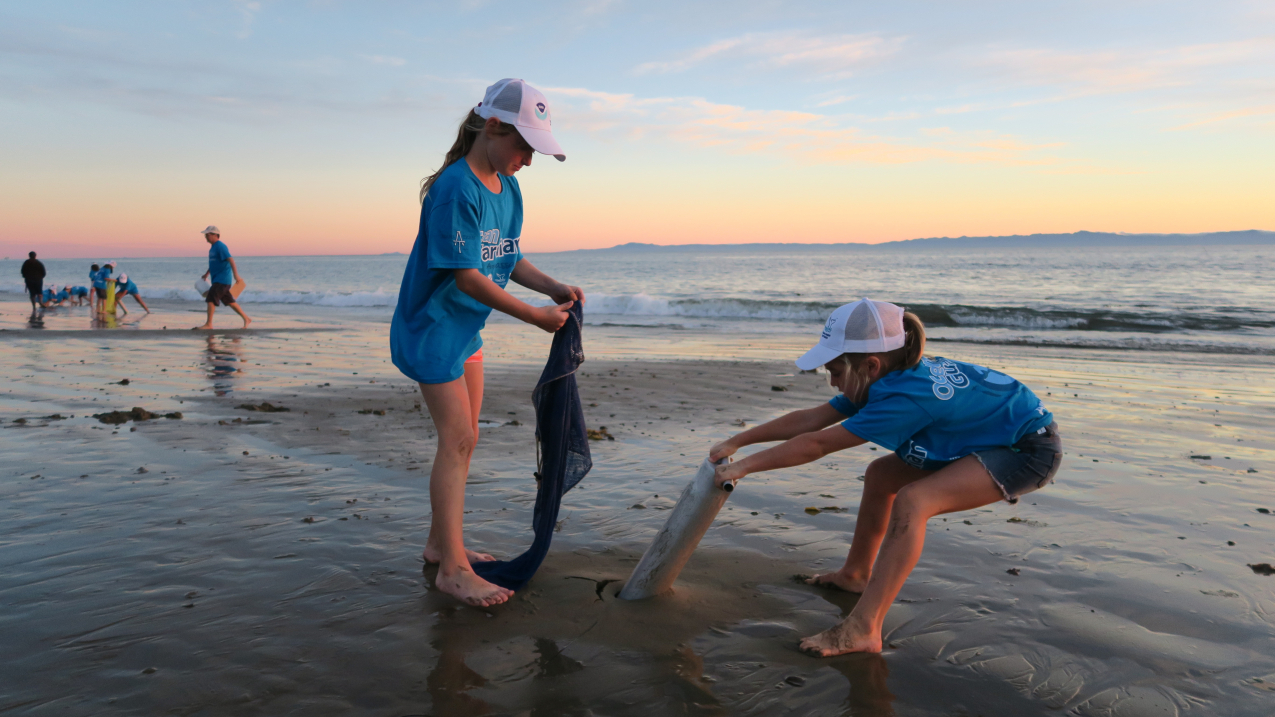
Students from a Title I elementary school in Santa Barbara participate in LiMPETS sandy beach monitoring as part of their Ocean Guardian Ambassadors program. (Image credit: Claire Fackler, NOAA National Marine Sanctuaries)
NOTE: This page is no longer being updated or maintained.
You can find more elementary lessons, activities, units, and much more in our Sea to Sky database. You can bookmark this link, which will take you directly to the Sea to Sky database with elementary ages, life science, and lessons, activities, and units pre-selected. You can further refine by subject, topic, or other filters as needed.
A "key" to Alaskan fish ID offsite link
5th - 7th grade • Links to standards
Students examine pictures of ten Alaskan fish species and design a taxonomic (dichotomous) key that can be used to identify them.
Fish fetch: Fisheries survey activity
K - 8th grade
Students learn how to use sampling to estimate the number of fish in a population.
Let's compare and contrast whales offsite link
K - 2nd grade • Links to standards
Students research a whale species then compare and contrast their whale with another using a Venn diagram.
Mystery of the dead whale: A forensic marine science unit offsite link
3rd - 12th grade • Teacher guide • Links to standards
In this short collection of lessons, the classroom is turned into a NOAA ship to solve the mystery of a dead whale. Students collect tissue samples, analyze data, and test real fish for contamination.
Marine osteoporosis offsite link
3rd - 8th grade • Teacher guide • Links to standards
Students will explore and test how ocean acidification affects different organisms, including humans. Students investigate causes of increased ocean acidity and discuss ways to minimize the impact.
Octopus adaptations offsite link
3rd - 5th grade • Teacher guide • Links to standards
Students learn about an octopus’s camouflage and anatomy as adaptations to its environment.
Oysters in the Chesapeake Bay
K - 12th grade • Teacher guide • Links to standards
Students learn about oysters in this extensive K-12 learning sequence. Each grade-specific lesson targets a specific area in the study of oysters.
Sanctuaries themed elementary collections
K - 6th grade
In celebration of the 50th anniversary of the National Marine Sanctuary System, the best of the best educational materials for an elementary school audience have been compiled in collaboration with the National Park Trust. Discover Spectacular with these education and outreach digital materials focused on 10 exciting topics: climate change, ocean acidification, marine debris, kelp forest ecosystems, coral reef ecosystems, sea turtles, sharks, whales and ocean noise, seabirds, and shipwrecks.
Sanctuary splash: Acoustics of cetaceans offsite link
4th - 6th grade • Teacher guide • Links to standards
Students will listen to whale vocalizations and participate in simulations of sound perception and efficiency of sound transfer through matter. Students will also gain a basic understanding of how sounds are measured and recorded when studied in a marine environment, and how various cetacean species communicate and are identified by the vocalizations they make.
Sargassum hide-and-seek offsite link
3rd - 5th grade • Links to standards
Students will learn the role that sargassum, a type of brown algae, plays in the marine ecosystem and research organisms that live in it.
Shark chalk walk offsite link
3rd - 5th grade • Links to standards
Students research different shark species. They identify sharks by observing their anatomy and looking at the type of prey that the shark eats.
Starfish adaptations: Peer taught offsite link
2nd - 5th grade • Links to standards
Students observe, explore, dissect, and compare sea stars to understand which particular traits make them successful in their habitat.
Where in the world does my seafood come from? offsite link
4th - 8th grade • Links to standards
Students research the ecosystems, food webs, and historical population levels of the fish found in their local grocery store and present what they learned to the class.
Winged ambassadors offsite link
5th - 12th grade • Teacher guide • Uses data • Links to standards
In this collection of five lessons, students learn about albatrosses, their migration patterns, and how they are impacted by marine debris.
Zooplankton migration patterns offsite link
1st - 12th grade • Teacher guide • Uses data • Links to standards
Students learn how behavioral adaptations of zooplankton (migration patterns) increase their chances of survival.

